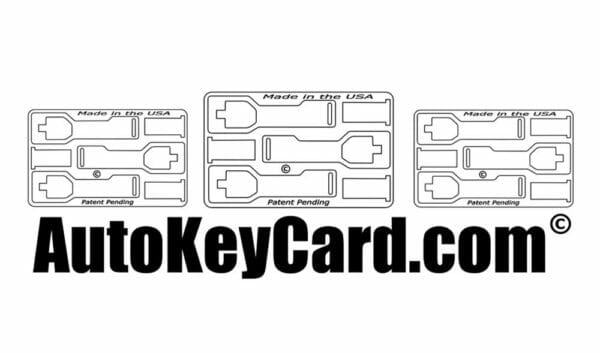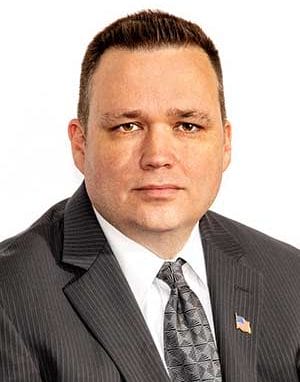
The first week of the Autokey Card case shows how weak the government’s prosecution against Matthew Hoover of CRS Firearms and the owner of the Autokey Card company, Justin Ervin, is based on the state’s witnesses.
The Autokey Card was a flat piece of metal with a picture inspired by a lightning link etched on it. Mr. Ervin is accused of selling the items on the Internet. The government charged Mr. Hoover because Ervin advertised on his YouTube channel, CRS Firearms.
The trial started with jury selection. The government eliminated anyone that thought the Bureau of Alcohol, Tobacco, Firearms and Explosives (ATF) could not regulate machine guns. The defense asked the potential jurors who believed that AR-15s should be banned. They chose to eliminate those citizens.
The case kicked off with ATF Special Agent Hooker taking the stand. The government spent all day tying Mr. Ervin to the company that produced the Autokey card. SA Hooker made a controlled buy of the product and shipped it to himself. The government asserted he could open the package without a warrant since it was sent to him. They tracked the money order back to Mr. Ervin’s bank, but we would later find out the bank is where the saga started.
The Florida man has freely admitted that he was selling Autokey Cards, but the government was hell-bent on showing that he owned the company anyway. The ATF used bank surveillance footage of Ervin cashing a money order sent to the company. They took the bank images and compared them to Ervin’s driver’s license.
On the second day, the lawyers for the defense got a shot at questioning SA Hooker. Hoover’s Attorney, Zachary Zermay, asked Hooker how many agents worked the case against the two men. The special agent couldn’t give an answer as to the number of agents assigned to the law enforcement investigation. Zermay kept asking the question leading the prosecutor to object, stating that Zermay was badgering the witness. After a sidebar, the questioning continued.
Next up, it was Erivn’s defense attorney’s turn to take a crack at the witness. Ervin’s attorney asked SA Hooker how many of the over 1000 Autokey Cards taken from Ervin and Hoover were cut out. Hooker admitted none were cut out. The attorney then asked Hooker how many of the 900 Autokey Cards recovered from the public had been cut out. The ATF agent once again admitted that none were cut out. It seems the ATF has yet to recover an Autokey Card that was cut out, and the ATF might have been the only one that has been machined out.
One of the critical pieces of evidence was emails sent to Ervin by customers asking how to cut out the card and make it work in their AR-15s. None of these emails had any type of response.
The state is trying to make a case that these emails show intent. SA Hooker had to admit under heavy cross-examination that the ATF couldn’t even be sure Ervin saw the emails regarding modifying the Autokey Card.
On the third day, the postal inspectors for the United States Postal Service (USPS) testified that it was Ervin that mailed out the Autokey Cards. They did so through video surveillance and opening packages. This fact was never in dispute by the defense. Mr. Ervin freely admits that he shipped the Autokey Cards to customers through the USPS.
The Community First Credit Union (CFCU) bank, the bank Ervin used, tellers were next to testify. The tellers stated that Justin Ervin came into the bank and wanted to withdraw a large sum of money. The bank had a limit on the amount of money he could withdraw. Mr. Ervin was upset and didn’t want to take a cashier’s check or wait a few days for the money, so he took the maximum amount and then went to other branches to take the maximum amount of cash there to get the amount of money he wanted.
The government is charging Ervin with structuring. Structuring is a financial crime for a defendant who takes out small amounts of cash to avoid triggering automatic red flags put into place by the Patriot Act. In this case, Mr. Ervin only allegedly structured his withdrawals due to bank limitations. He could have taken a cashier’s check, but he needed the cash for a large legal purchase unrelated to the Autokey Card. This fact is something the government doesn’t dispute.
Mr. Ervin also got into a dispute with the bank when he tried to deposit a check from his Autokey Card business into his account. The bank has a policy against letting customers use their personal checking accounts for businesses. These run-ins led to a domino effect.
The multiple disagreements with the bank led one teller to look up Mr. Ervin’s business. Alarmed by the Autokey Card site, she contacted her friend, an ATF Special Agent in Texas. That friend referred her to a Special Agent in Florida, leading to the Autokey Card investigation.
The next day, the state called the manufacturer to testify. But before the tech testified, the prosecutor made a big deal about Mr. Ervin’s father sending a text message to him saying to be careful when coming home because an “undercover cop car” was parked down the street. The government claims that the men knew they were being watched by the ATF even though the text was sent before the investigation began. It could be that his dad was concerned the undercover cop car was running radar, which was the case.
The laser tech that worked for the manufacturer, John Carlos Ruiz, was the first to testify about the manufacturing of the Autokey Card. He testified that Ervin’s main concern was the finish of the card and was the reason why it was etched. When finishing the card, any ink-based product would be removed. Mr. Ervin told Mr. Ruiz that the card was a free speech and political statement. He called it “satire.”
Mr. Ervin was worried only about the ascetics of the cards. He didn’t care or have any input on the stainless-steel thickness used in manufacturing the Autokey Cards. The prosecutors claimed that Ervin wanted the lines obvious to make it easy to cut out, but Mr. Ruiz contended that the manufacturer decided on the depths of the etching and not Ervin, although Mr. Ervin stated he didn’t want a deep engraving.
The prosecutors said the original DXF file was changed to make the lightning links etched on the Autokey Cards easier to cut out. On cross-examination, the laser tech admitted that he was the one to change the DXF file to make it look better. A DXF file is a computer file used by laser techs to engrave materials.
Next up was the Director of Manufacturing, Patrick Brezline. Mr. Brezline spoke with Ervin multiple times and confirmed that Ervin brought the project to the shop to complete the work. This fact is something that isn’t in dispute.
On cross-examination, Mr. Brezline admitted to suggesting that they tap the cards to make them easier to pop out. Mr. Brezline said, “Ervin didn’t want that” and wanted the etching shallow because he was worried about bubbling. He was concerned that the bubbling would take away from the ascetics of the cards.
On the fifth day of the trial, the prosecutors tried to tie Youtuber Matt Hoover to the Autokey Card. Hoover advertised the Autokey Card through his CRS Firearms YouTube channel. He never sold the card or owned the company.
The government claims he entered into a conspiracy with Ervin to sell “machine guns” to the public, which the government claims the Autokey Card is designed for use.
The prosecutors played every video where Matt Hoover advertised the cards. In two videos, Hoover discussed what the cards could be used for if a person decides to break the laws, but most video shown to the jury is Mr. Hoover telling people to follow all rules and calling the cards a novelty.
The trial is expected to last at least another week. Although the judge wants the trial to wrap up on Friday, it seems unlikely, especially when the court will be in recess on Tuesday. Both Mr. Hoover and Mr. Ervin are facing lengthy prison sentences if convicted.
About John Crump
John is a NRA instructor and a constitutional activist. John has written about firearms, interviewed people of all walks of life, and on the Constitution. John lives in Northern Virginia with his wife and sons and can be followed on Twitter at @crumpyss, or at www.crumpy.com.

from https://ift.tt/k08ZMES
via IFTTT

No comments:
Post a Comment